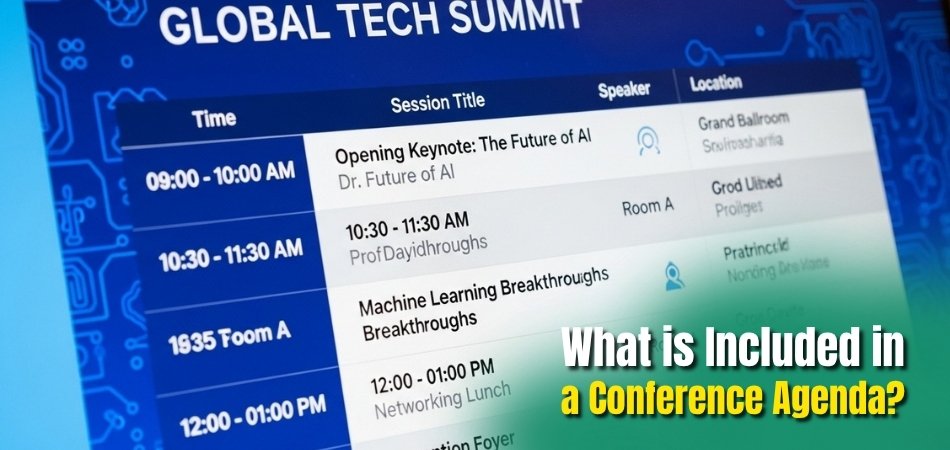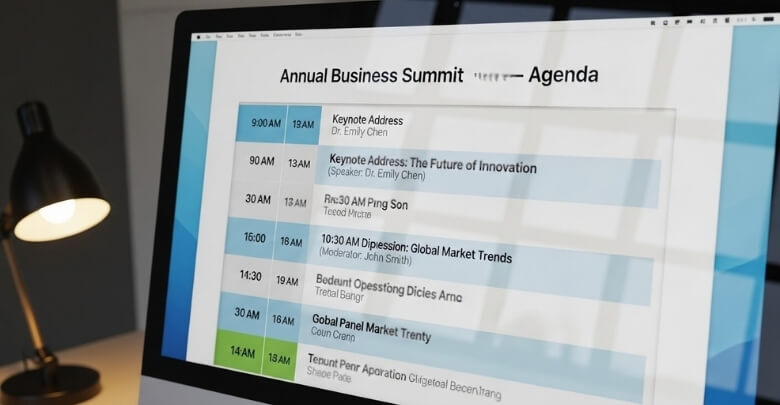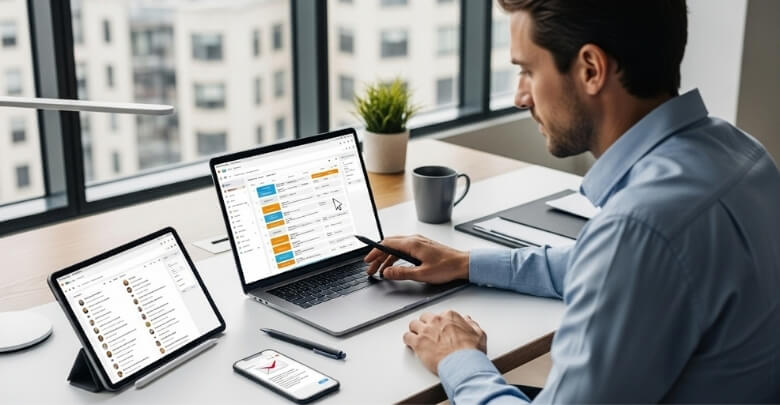Everything stays on course, and the event runs more smoothly with a carefully thought-out conference agenda. It shows when sessions start, who the speakers are, and where each part happens. Many people often think about how to make one and wonder what is included in a conference agenda.
A conference agenda includes the event overview, keynote sessions, workshops, networking times, and logistical details. It lists speakers, session titles, meal breaks, and venue locations. A clear agenda keeps attendees organized and ensures the event runs smoothly from start to finish.
Do you want to learn more about how a good conference agenda is arranged and made engaging? Keep reading this article to find all the key information you need about it in simple and clear sections.
What is Included in a Conference Agenda?
A conference agenda helps everyone understand how the event will run. It gives clear details about sessions, speakers, and important times. With a good agenda, attendees know where to be and when. Keep reading below to learn what is usually included in a complete conference agenda.
Event Overview
Every agenda starts with an overview that explains what the event is about. It includes the conference title, dates, and main goals. The location and time are also clearly listed. This helps people plan their travel and prepare for what’s coming.
Opening and Closing Sessions
Most events start with an opening session that welcomes guests. It shares the main theme and purpose of the day. The closing session wraps up the event and thanks everyone. These sessions bring structure and a nice beginning and end to the program.
Keynote Speakers
Special speakers often lead keynotes to inspire and inform. They usually talk about the main topic of the event. Their sessions give insights and spark interest among attendees. These talks are often the highlight of the conference schedule.
Sessions and Workshops
Breakout sessions and workshops let people dive into different topics. They are smaller and more focused than the main sessions. Attendees can choose which ones fit their interests best. Especially for international events like upcoming conferences in USA, Canada, or any other country, workshops help make learning more personal.
Breaks and Meals
Short breaks are added between sessions to keep people fresh and alert. Coffee, snacks, and lunch breaks give time to relax and recharge. These moments also allow people to chat and build new connections. A well-timed break helps keep the day enjoyable.
Networking Opportunities
Conferences often include time for people to meet and share ideas. These moments may happen during lunch or special meetups. Networking builds friendships and helps people work together in the future. A good agenda always includes space for these interactions.
Speaker and Session Details
Each session in the agenda lists the speaker’s name and title. Short bios may tell what they do or where they work. The session titles and short descriptions help attendees pick what to attend. These small details make planning much easier.
Room and Venue Information
Clear room names and locations help everyone find where they need to go. The agenda often lists floor numbers or hall names. This saves time and avoids confusion during the event. Maps or venue layouts can also be added for big conferences.
Logistical Information
Useful details like contact numbers or email addresses should be included. Some events share pre-event materials that attendees can read beforehand. Action items or follow-up steps can also be added here. These help people stay organized even after the event.
A good conference agenda gives direction and keeps things running smoothly. It helps guests, speakers, and organizers stay on the same page. Each section plays a key part in making the event a success. Plan your agenda with care and make every detail count.
Common Things People Forget to Include in a Conference Agenda
Planning a conference takes more than just listing speakers and sessions. Small but important details are often missed, which can affect the whole event. Here are some common things people forget to include in a conference agenda.
- Extra Buffer Time: Giving short breaks between sessions helps everyone rest, move to another room, and prepare for the next talk without feeling rushed or missing anything important.
- Setup Time for Speakers: Allowing speakers to test their slides, check microphones, and prepare the stage ensures smooth starts and prevents awkward pauses or late beginnings.
- Technical Check Slots: Running quick checks for audio, video, and internet before sessions avoids sudden technical problems like muted mics or failed screen sharing.
- Clear Room Names: Including clear room names, directions, and visible signs helps attendees find their way easily and reduces confusion during transitions between sessions.
- Announcement Time: Setting aside a few minutes for quick event updates, reminders, or important messages helps everyone stay informed and on track.
- Meal Details: Mentioning meal times, locations, and available dietary options prevents confusion and keeps everyone satisfied during long conference days.
- Networking Time: Adding time for informal networking lets people relax, meet others, and build useful connections outside of formal sessions.
- Q&A Sessions: Including time for questions after the main talks helps the audience interact with speakers and get clear answers to their doubts.
- Contact Information: Providing organizer and help desk contact details ensures that attendees can easily get help if they face any problems.
- Closing and Feedback: Ending with a short closing and feedback session allows everyone to share thoughts, thank the team, and finish the event smoothly.
Adding these small but meaningful details to your conference agenda makes a big difference. It keeps everything organized, helps people feel comfortable, and ensures the whole event runs smoothly from start to finish.
How to Arrange the Included Items in a Conference Agenda?
A good conference plan helps the day run smoothly and keeps people interested. Every part of the schedule should connect well with the next one. The order of talks, breaks, and sessions affects how people feel during the event. Let’s look at how to arrange everything in the right order so the day flows well.
Start With the Opening Session
Begin the event with a strong welcome session. This part sets the tone for the whole day. Include a short speech, greetings from the host, and a quick overview of the day. It helps people know what to expect and gets them ready for the sessions ahead.
Place Keynote Speeches Early
The keynote should come right after the opening. People are most alert in the morning, so it’s a good time for big speeches. The keynote gives the main ideas and themes for the day. It connects the audience to the event’s main goals in a clear and simple way.
Add Interactive Sessions Next
After the keynote, plan some engaging or group activities. It could be a Q&A, a short workshop, or a panel talk. These sessions let people share ideas and stay active. While planning the order of sessions, think about how different conference agenda topics connect to each other to keep the schedule smooth and easy to follow.
Schedule Lunch and Networking Time
Midday breaks help people rest and talk with others. A good lunch break gives time to relax before the next part of the program. Add a few minutes for networking too. It helps people share their thoughts about the morning sessions and get ready for the afternoon.
End With Closing Remarks and Thanks
Finish with closing remarks to sum up the main points. This part gives a sense of completion and appreciation. You can include final thanks to speakers, sponsors, and guests. End the day on a warm and positive note so people leave with a good memory of the event.
A well-planned schedule makes any event feel smooth and enjoyable. Each session should fit nicely with the next one in time and tone. Keep the energy level steady throughout the day for the best flow. Follow these steps to create a clear, easy-to-follow conference agenda that everyone will enjoy.
How to Make the Included Items in a Conference Agenda More Engaging?
A good conference agenda keeps people active and happy all day. It mixes learning, sharing, and small moments of fun. A boring list of long talks can make people lose interest fast. Read below to find easy ways to make every part of your agenda more lively and fun for everyone.
Add Quick Icebreaker Games
Start with a short game to make people feel relaxed and friendly. A simple quiz or a “find someone who” activity can help people talk and laugh. This helps break the silence and builds a good mood. Small, fun moments early on make everyone feel welcome and ready to join in.
Include Short Q&A Sessions
People like to share their thoughts and ask questions. Add Q&A time after each talk to keep it interactive. It makes the session feel like a two-way chat instead of a lecture. While writing an agenda for a conference, focus on adding short activities, open discussions, or Q&A sessions to keep attendees interested and active throughout the event.
Plan Small Energizing Breaks
A short stretch or breathing break can do wonders. Add a five-minute move session or a light snack break between long talks. It helps everyone refresh their minds and stay alert. These breaks give people time to relax before the next topic starts.
Make Networking Fun and Easy
Turn networking into a fun task instead of a formal session. Use games like “business card bingo” or “speed chat” to help people meet new faces. This adds a friendly touch and helps people connect naturally. Everyone enjoys learning and laughing together this way.
Use Polls and Live Feedback
Add live polls or quick feedback spots to make talks more fun. Use tools where people can vote or share their thoughts instantly. This makes sessions more lively and helps speakers adjust their talk. It keeps the crowd awake and feeling part of the moment.
End With an Interactive Recap
Close the event with a group recap or mini quiz. Let people share what they learned or liked most. It adds a personal touch and ends things on a positive note. When people leave smiling, they remember the conference better and feel excited for the next one.
A well-planned agenda can make any conference feel exciting and smooth. Adding small, fun parts helps people stay focused and happy all day. It also creates good memories and strong connections among attendees. Keep it simple, fun, and full of friendly energy for the best results.
How Does Technology Help in Managing What’s Included in a Conference Agenda?
Planning a conference can be tough when there are many sessions, speakers, and updates. Keeping everyone on the same page is even harder with last-minute changes. That’s where technology makes things smoother and faster. Let’s look at how event apps and digital tools make managing agendas easy and clear for everyone.
Keeps the Agenda in One Place
Event apps bring the full schedule into one easy spot. Attendees can see the sessions, speakers, and times without searching through papers. Organizers can also plan every part in the same system. It helps avoid confusion and saves time for both sides.
Makes Sharing Simple
Once the agenda is ready, digital tools make sharing super fast. Organizers can send it through the app, website, or email with one click. Attendees get instant access and can even add sessions to their calendars. This makes sure everyone knows what’s happening.
Updates Happen Instantly
If a speaker changes or a session moves, apps can update everyone right away. Push alerts or messages go out so attendees know what’s new. There’s no need to reprint papers or make long announcements. It helps keep the whole event on track easily.
Helps With Time Management
Digital tools can help manage time better by showing real-time schedules. Organizers can see which sessions overlap or need more breaks. Attendees can plan their day and avoid missing key talks. This makes the whole event run smoothly and on time.
Improves Communication
Conference apps often have chat or Q&A options for attendees. This makes it easier for people to ask questions or get help quickly. Organizers can share reminders or session highlights as well. It builds a better link between everyone at the event.
Technology makes planning and sharing a conference agenda much easier. It helps everyone stay updated without stress or confusion. Organizers save time while attendees enjoy a smoother event. Using smart tools is the best way to keep things clear and simple.
FAQs About What is Included in a Conference Agenda?
Here are some common questions people ask about conference agendas. These answers will help you understand how agendas work and why they matter. Each point explains a part that organizers often plan behind the scenes. Read through them to get a full idea of how a good agenda makes an event run smoothly.
Why is a Conference Agenda Important for Attendees?
A conference agenda helps people know what to expect during the event. It lists every session, break, and activity in a clear order. Attendees can plan their time and choose which parts to join. It also keeps everyone organized so no one misses important sessions.
How Does a Conference Agenda Help Organizers?
For organizers, the agenda acts like a guide to run the event smoothly. It helps the team know when and where each activity happens. With a clear plan, they can manage time, speakers, and setup easily. It also reduces stress because everyone knows their role and timing.
What Details Should Be Added to Each Session?
Each session in the agenda should have a title, time, and speaker name. It’s also helpful to include a short note about the session topic. This helps people know what the session is about before they attend. Clear details make it easy to follow and avoid confusion.
How Long Should Each Session Last in a Conference Agenda?
The time for each session depends on the type of talk or activity. Short talks can last 15 to 20 minutes, while panel discussions might take an hour. It’s important to keep sessions balanced so people don’t feel tired. Adding small breaks helps keep everyone fresh and focused.
How Can Organizers Make the Agenda Easy to Read?
A clean and simple layout makes the agenda easy to follow. Use clear headings, time slots, and short session names. Color-coding or dividing by day can also help people scan it quickly. A good design helps attendees find information fast without getting confused.
Should a Conference Agenda Be Shared Before the Event?
Yes, it’s best to share the agenda a few days before the event. This gives attendees time to read and plan which sessions to attend. It also helps speakers prepare for their parts ahead of time. Sharing early builds excitement and reduces last-minute confusion.
How Can the Agenda Be Adjusted During the Event?
Sometimes plans change during the event, like speaker delays or room changes. Organizers can update the agenda quickly using screens, boards, or apps. Announcing changes through messages helps everyone stay informed. Being flexible keeps the event running smoothly, even with changes.
What Role Does Timing Play in a Conference Agenda?
Timing is one of the most important parts of a good agenda. Each session, break, and meal must start and end on time. When timing is managed well, the day feels smooth and comfortable. Good timing also shows respect for the speakers and attendees.
How Can the Agenda Support Audience Engagement?
The agenda can include short polls, Q&A spots, or small activities. These parts make the event more active and fun for the audience. People stay more focused when they can take part, not just listen. Mixing learning and interaction keeps everyone happy and alert.
What Makes a Conference Agenda Successful?
A successful agenda is clear, balanced, and well-timed. It includes all key parts like sessions, breaks, and networking time. Everyone knows where to be and what to expect next. When the plan works smoothly, it creates a positive and stress-free experience for all.
Final Words
A well-made conference agenda keeps the whole event running smoothly and on time. It helps everyone know where to go and what to expect next. Each section plays a key role in keeping people engaged, informed, and ready to take part in every session.
When people ask, what is included in a conference agenda? the simple answer is that it covers everything from opening and closing sessions to speakers, workshops, breaks, and networking times. It also includes key details like locations, contact info, and event goals that guide everyone easily through the day.
To make your agenda stand out, keep it clear, fun, and well-timed. Add small breaks, Q&A slots, and friendly activities to make the day lively. Always plan ahead, stay flexible, and enjoy creating an event that leaves everyone smiling. Best wishes for your next successful conference!








